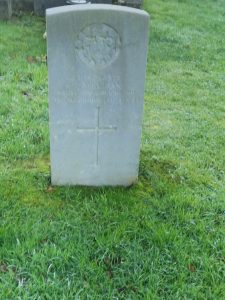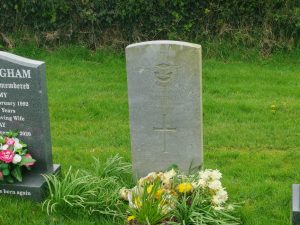Bailey, A (Arthur)

Bailey, A (Arthur)
Private Arthur Wright Bailey was the son of Thomas Bailey, of 5, Barnwall Place, Waterside, Londonderry. He died at home in the presence of his younger brother Ernest. His older brother Thomas had been killed at the Somme by a bullet on the 1st of July 1916 while serving with the 109th Machine Gun Company,[1] they had joined the 10th Inniskillings together.
Arthur’s war began when he originally landed in Boulogne,[2] France on the 6th of October 1915 at 1:30am along with the 10th Inniskilling Fusiliers. There were 1029 men, all ranks.
At 14.00 they went on a route march with their band, from Boulogne, arriving at 10.00 the following day at Gare Central station[3] where they entrained and travelled to Coisy[4] and were billeted. At this point they started training and improving where they slept. Soon they were on the move again. Training continues, and they were eventually attached to other battalions at Hebuterne[5] to help them gain some experience in trench warfare.
Training continued, and the battalion marched from area to area. When the time came to celebrate the “Closing of the Gates of Londonderry (December 1668)”, the battalion still had no casualties or real front-line experience.
During March, they went to Forceville[6] and the trenches at Thiepval Woods[7] where they relieved the 9th Royal Inniskilling Fusiliers and started receiving their first casualties. This continued into April and up until May when they moved to Léalvillers[8] The battalion remained here until mid-June when they moved back to Forceville and the Thiepval Woods area.
On the evening of the 30th of June 1916, the battalion moved forward to take up their positions at Thiepval Woods. Whilst walking through Aveluy Woods[9] towards the trenches the 10th Inniskillings commanding officer, Lieutenant Colonel Ross Smyth slipped and sprained his leg and was evacuated. A bad omen of things to come.
With the 9th and 11th Inniskilling Fusiliers on their right and 14th Royal Irish Rifles with them they waited in crowded trenches on the 1st of July for the bombardment of the German lines to finish. The men were all issued a portion of rum as they paused before putting their training into place and entering “No man’s land”, playing their part on the day of the “Great attack”.[10]
The battalions got mixed up as they advanced causing some confusement and even worse advancing too quickly, this caused heavy casualties from friendly fire. Within 100 yards of the enemy’s trench, they lay down awaiting the moment to attack. The company bugle calls soon followed announcing their orders to advance again.
All-in-all 764 men left the trenches, only 346 returned. The battalion eventually left the front line on the 2nd of July to regroup and rest, but only until August when they were redeployed at Ploegsteert Woods.[11]
Time passed by whilst the battalion continued to receive casualties and new recruits, raid German trenches, man trenches, bomb, be bombed and repeat. This continued until the end of October when they went to the village of Dranoutre,[12] to rest, bathe and be reissued uniform.
The Inniskillings remained here until mid-November when they set off to the Ypres area of Belgium, to man the trenches at Bailleul.[13] They stayed right through to the end of the year when they moved to Ploegsteert woods. Here they stayed until February when they went to Bulford camp and became divisional reserves. March ended with the battalion taking part in Brigade sports in Acquin-Westbécourt,[14] with mixed success, by Mid-April they had returned to the trenches in the Spanbroek sector.[15] They remained in this general area until mid-May when the Inniskillings moved from the front to Wakefield Huts, in the rear. Even here though they received shells throughout their stay.
The end of June found the men in the trenches again in the Spanbroek sector. Casualties over the previous few months were all from German shells and nothing changed as they month ended, and July began.
July was a quiet month, the battalion moved about and received medal notifications, but no casualties. Near the end of the month though they received orders of a new advance, one they would share with the 9th and 11th Battalions. By the 8th of August they had arrived in the Ypres area and advanced on the 15th. Lessons had been learned and this time the battalion only lost 41 men dead and 59 wounded or missing. They successfully took the German trenches and were soon withdrawn to Winnezeele[16] in France.
Life continued for the men as they served in various locations, mainly in reserve, whilst leave was given, sports were played, men trained, and some spent time in working parties. It was now noticeable that no replacements were arriving to replace those lost at Ypres, but by December they were back in the front line at Bertincourt.[17]
On the 5th of December 1917 they attacked, once again due to better training the casualties remained low. One officer 2nd Lieutenant Sherman of “A” company was shot when six Germans pretended to surrender only to shoot the officer when he moved forward towards them. Corporal Blake[18], who was with the officer immediately opened fire and killed two of the Germans. He then carried the officer back to the trenches.
Soon the 10th was back in reserve, snow was now falling, and they spent some time clearing roads and repairing trenches. They were not to know that their time was short and by the end of January the 10th Inniskilling were disbanded. The men were sent to various other battalions and jobs. There were no longer enough young men to replace the dead, missing and wounded.
Private Arthur Wright Bailey now left the 10th and joined the 2nd Battalion of the Inniskilling Fusiliers. He had been one of the lucky ones and had survived the events without a wound. It is unknown when he exactly joined the 2nd Battalion, but he finished the war with them and continued to serve right up to 1919.
Arthur would survive the war but died ultimately from wounds possibly received in the front or the effects of gas, his nephew Ernest was by his side at 5, Barnwall Place, Waterside, Londonderry. He never married and had no children.
Private Bailey was awarded the 1914/15 Star, the British War and Victory Medals.
Date of Death: 27/04/1921 (Aged 28)
Service: Royal Inniskilling Fusiliers 10th and 2nd Battalions.
Service Number: 15306
Burial Location: Old ground East part. Glendermott Church of Ireland Churchyard and New Cemetery.
[1] 109th Machine Gun Company suffered 95 men missing, wounded or dead-on the 1st of July 1916.
[2] Boulogne or Boulogne-sur-Mer is a coastal town in northwest France.
[3] Gare Central Station is around 16 miles south of Boulogne.
[4] Coisy is around 60 miles, southeast of Gare Central station.
[5] Hebuterne is an area in France around 20 miles northeast of Coisy.
[6] Forceville in an area in France in between Thiepval Woods and Léalvillers.
[7] Thiepval Woods is around 6 miles south of Hebuterne.
[8] Léalvillers is an area in France around 7 miles east of Thiepval.
[9] Woods just west of Thiepval Woods.
[10] Great attack, later called the battle of the Somme.
[11] Ploegsteert Woods is in southern Belgium about 60 miles north of Thiepval woods.
[12] Dranoutre is a small village in Belgium around 6 miles west of Ploegsteert Woods.
[13] Bailleul is an area in Belgium 6 miles northeast of Dranoutre.
[14] Acquin-Westbécourt is an area in northwest France.
[15] Spanbroek sector is in Spanbroekmolen, Belgium. A few miles south Ypres and close to Kemmel village.
[16] Winnezeele is in northern France and is about 15 miles west of Ypres.
[17] Bertincourt is in northern France some 60 miles south of Ypres.
[18] Corporal Edward Blake, 24768, 20798, would be awarded the Distinguished Conduct Medal and Military Medal. He was from Omagh, County Tyrone in Ireland. He survived the war.







